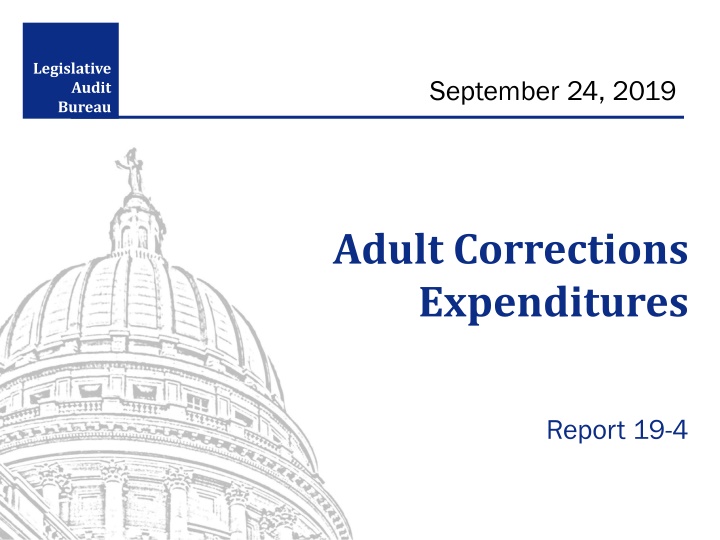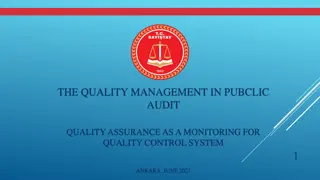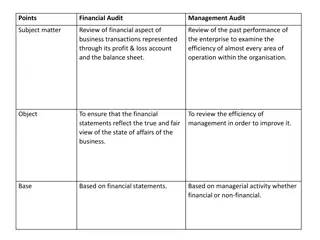Audit Report on Adult Corrections Expenditures
Adult corrections expenditures report from the Legislative Audit Bureau highlights trends in inmate population, operating expenditures, employee wages, turnover rates, vacancy rates, and inmate health care management issues. The report identifies areas of growth in corrections spending and offers recommendations for improving management practices to potentially reduce future costs.
Download Presentation

Please find below an Image/Link to download the presentation.
The content on the website is provided AS IS for your information and personal use only. It may not be sold, licensed, or shared on other websites without obtaining consent from the author.If you encounter any issues during the download, it is possible that the publisher has removed the file from their server.
You are allowed to download the files provided on this website for personal or commercial use, subject to the condition that they are used lawfully. All files are the property of their respective owners.
The content on the website is provided AS IS for your information and personal use only. It may not be sold, licensed, or shared on other websites without obtaining consent from the author.
E N D
Presentation Transcript
Legislative Audit Bureau September 24, 2019 Adult Corrections Expenditures Report 19-4
Adult Inmate Population The total adult inmate population declined from 22,672 in 2009 to 21,941 in 2011. The inmate population grew from 21,941 in 2011 to 23,675 in 2018, or by 7.9 percent. 2
Operating Expenditures Total operating expenditures for adult correctional institutions increased from an estimated $909.3 million in FY 2013-14 to $933.9 million in FY 2017-18. The largest areas of expenditure growth included pharmaceuticals and medical supplies, professional services, information technology, and contract beds in county jails. 3
Employee Wages and Contract Staff Expenditures, FY 2017-18 Of the $397.5 million in wages in FY 2017-18, $52.9 million (13.3 percent) was for overtime hours. Total overtime worked in FY 2017-18 was the equivalent of 894 FTE employees. DOC did not provide the number of hours worked associated with $5.9 million it paid for contract staff. We recommend DOC record all hours worked. 4
Employee Turnover from FY 2013-14 to FY 2017-18 Overall average turnover increased from 18.6 percent to 24.0 percent. Turnover for correctional officers increased from 17.8 percent to 26.1 percent and varied among institutions. Health and social services personnel had the highest turnover rate in both years at 24.4 percent and 31.7 percent, respectively. 5
Managing Inmate Health Care We identified problems with the completeness and accuracy of required reports that prevented a meaningful analysis of inmate health care indicators. DOC s use of its new electronic medical records system would enable DOC to improve management of inmate health care and potentially reduce future expenditures. We recommend DOC report to the Committee by January 15, 2020, on inmate health care. 7
Managing Inmate Health Care (Continued) We estimate that Medical Assistance coverage for inpatient inmate care saved the State approximately $40.8 million from April 2014 through July 2018. DOC has not taken advantage of some opportunities to reduce costs, such as consolidating inmate transportation to medical appointments and exploring the potential use of Medical Assistance funds to provide a nursing-home level of care to inmates with extraordinary health conditions. 8
Managing the Inmate Population DOC s adult institutions were at an average of 133.8 percent of design capacity in FY 2017-18. DOC increased the number of available contracted beds in county jails from 500 in May 2017 to 578 in June 2018. DOC should enter into written agreements with counties. 9
Recommendations Report to the Joint Legislative Audit Committee by March 3, 2020, on its efforts to: consistently track expenditures, develop outcome measures, and routinely evaluate the effectiveness of each of its treatment and educational programs; record hours worked by all contract staff and analyze costs; evaluate the effectiveness of salary add-ons, signing bonuses, training academies, job fairs, and a potential new pay progression system; 10
Recommendations (Continued) analyze and ensure the accuracy of data entered into its new electronic medical records system; work with DHS to develop a written agreement for administering the Wisconsin Resource Center; increase the use of telemedicine appointments as a cost savings measure; 11
Recommendations (Continued) require all of its institutions to record and analyze non-emergency medical trip data; implement a centralized transportation scheduling system; work with DHS to determine whether Wisconsin would be eligible to use Medical Assistance funds to provide a nursing-home level of care to inmates with extraordinary health conditions; 12
Recommendations (Continued) develop a plan for inmate placement and enter into contracts with all counties in which it places inmates; and establish relationships with counties with which it does not currently contract to provide additional capacity if needed. 13
Legislative Audit Bureau September 24, 2019 Adult Corrections Expenditures Report 19-4























